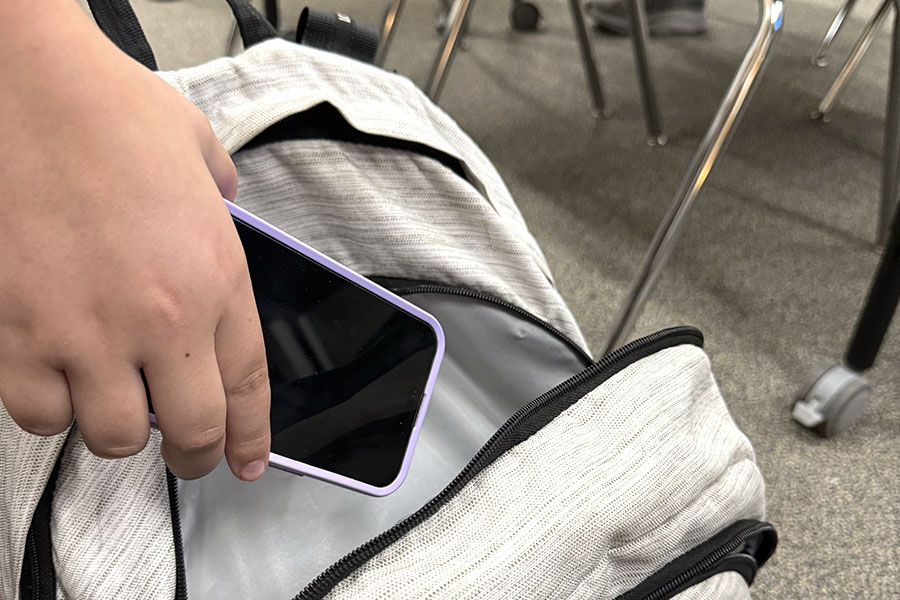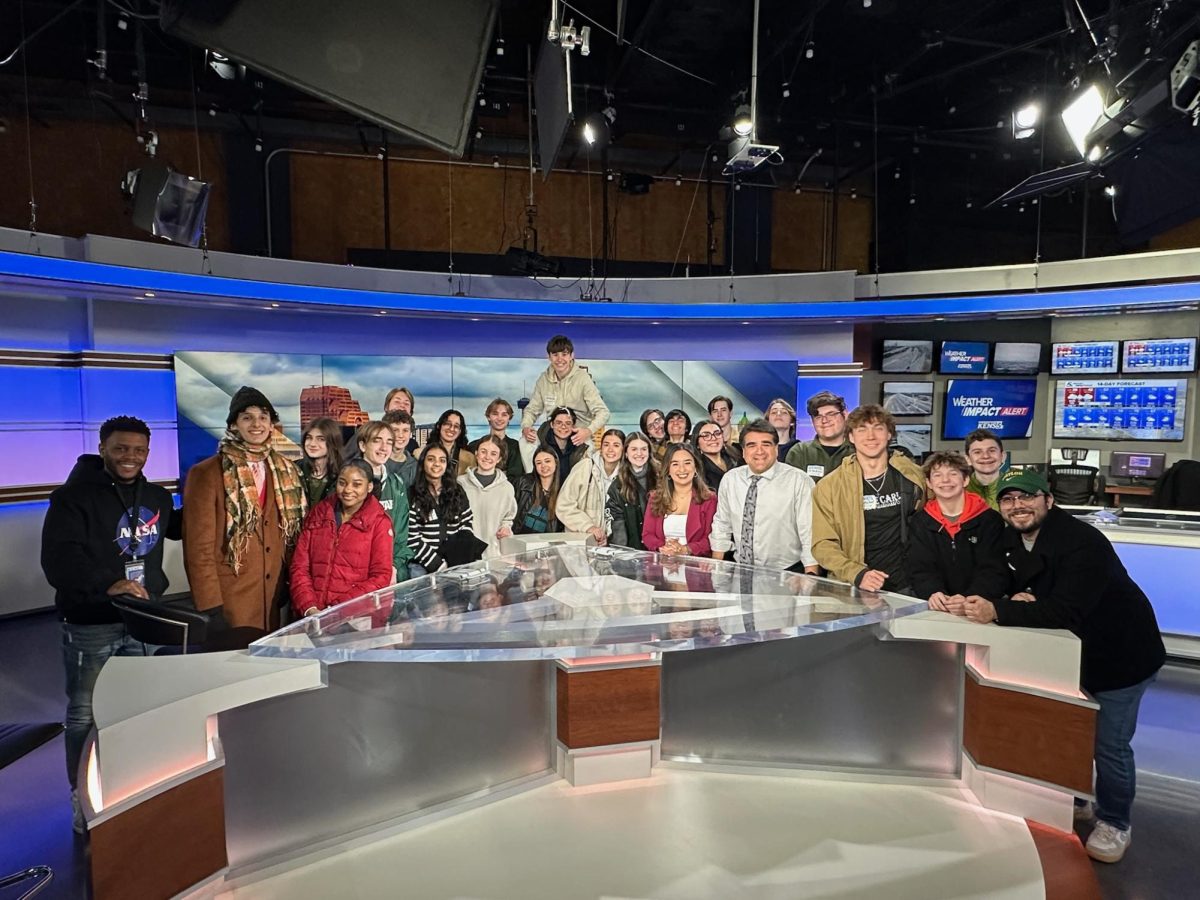Imagine…
by: Sarah Nation
How often do we hear from our fellow students, “this place is a jail,” or that “the rules are ridiculous?” Confusion abounds regarding changing standards for dress code as well as many of the common student rules and guidelines. To make matters worse, the rules seem to be different depending on whose classroom you are in as each teacher seems to have a different way of enforcing school policies. We thought that it would be interesting to set up a hypothetical scenario where the rules and school policies were a lot looser than perhaps most students ever imagined. What would be the consequences and benefits to such a reality?
Imagine an alternate reality in which the school structure is designed to encourage more flexibility and reliance on individual judgment in regards to behavior surrounding dress code, electronic devices and freedom of expression. Consider a scenario where the following conditions and rules have been adapted.
Cell phones are allowed in the building and in classes, but must be on silent or vibrate.
Students can make and receive text messages from parents or other students not in the same classroom as long as they do not create a distraction.
Students will put down their phone if a teacher asks them a direct question, or requires them to do so for tests or certain assignments.
Students can take a phone call, if considered an appropriate time and of an urgent nature, by going out to the hallway to answer the phone.
Students can wear whatever they want as long as the clothing is not obscene or too distracting.
Piercings are allowed.
Laptops and other electronic devices are allowed on campus for use when designated by the teacher.
In the corner on the right…
By: Megan Garza & Lauren Kuerth with collaborative input from Tristan Boyd
School rules exist for a reason. The school board of LISD places these rules in the student handbook to ensure a safe and productive learning environment. If these rules are relaxed, the academic performance of CPHS could very well spiral downward and the school could lose its recently bestowed ranking by the Texas Education Agency of “Recognized.” Rules are placed in schools because we are young adults. If we were given the liberty to do as we please, chaos would ensue during school hours.
It is true that we are in a society almost entirely dominated by technology, so it is understandable that the amount of students armed with the latest laptops and cell phones is rapidly rising. However, the classroom is an environment established for education; texting and taking calls should not be a priority. The school board is not blind to the fact that there are occasionally family emergencies that students might need to know about. In these cases there are policies that allow parents/guardians to phone the front office and have passes sent to their students. If need be, the student can then call back from the office phone. This system has worked for years and eliminates distractions from the classroom while allowing students to cope with emergencies in manners that do not disturb the class.
Where is the respect when a student is clicking at the buttons on a cell phone or cranking up the volume on an iPod rather than paying attention to the lecture? Using electronic devices while teachers are trying to provide an education is not only disrespectful, but also undermines an important aspect of what the education system is trying to accomplish; teaching kids standards and principles.
High school is the student’s last opportunity to have societal standards taught to them in a classroom setting, and to relax the rules for the purpose of creating a “more realistic atmosphere” would destroy this aspect of education. As students progress through the grades in public school, they begin to get more and more freedom to prepare them for the final step of college, where education is still strived for, but in a much more relaxed environment. To try to turn high school into college would disrupt the gradual process that transitions students from the strict regiment of elementary school to the free environment of college and the work place.
School policies are in place to discourage immature teenage behavior that is not appropriate for a healthy environment, not just disruptive cell phone use. Since we are all still young and most of us are easily distracted, things such as outrageous body and facial piercings, obnoxious tattoos, and unnatural hair colors only serve as further distractions. The district put these policies into place because they understand that students walking around with green Mohawks, eyebrow piercings, and sleeves tattooed up their arms would be a bit much when Mrs. Smith is extolling the problems with British Imperialism. Schools have expectations placed on them and, in turn, placed on students that have to be met, so rules are enforced to maintain those standards.
A major issue of this debate is dress code. Many teenagers believe that they cannot find trendy clothing that is conservative enough to comply with the rules. Yet this trendy clothing tends to be very revealing, to say the least, and therefore causes too many distractions in student interaction. Furthermore, the act of being “stylish” at school can be accomplished while still maintaining a school appropriate look; therefore, the dress code is something that should be kept. We pass no judgment on the styles of students at CPHS; however, the dress code instated in the school rules is the most logical.
LISD takes a very rational approach to cell phone and dress code rules that bear in mind the main goal of the entire district; to create the optimal environment for educating students. In high school, most students are not even legal adults yet and while some seniors may be responsible enough to handle more freedom, we must always keep in mind the lowest denominator. Students need to be taught, while they are young, the value of respecting educators, the importance of distraction free environments and of course the important educational material that is shattered with every obnoxious ringtone in the middle of class. After all, what does it profit students to gain the use of cell phones, and forfeit their education?
In the corner on the left…
By: Sarah Nation & Colin Meier
What is the objective of the current high school academic environment? Is it to provide a place in which students can learn and develop life skills, or is it simply a day care for adolescents?
As of now, high school is merely a playground in which kids can play by the rules, or sit in timeout. Schools set up all of these rules and restrictions that are supposed to help create a healthy and productive learning environment, but instead end up hindering the personal development that we all want students to achieve in the classroom. Personal growth comes from decisions that you make on your own, not by following rules that leave little room for independent thinking.
High schools are the last step towards developing an independent student ready to go on to college and live an independent life. Yet our high schools treat students like juvenile delinquents who are incapable of making responsible decisions. Our cell phone use is monitored, we’re told what we can and cannot wear, and even told when or if we may use the restroom. Is it any wonder why by the time students reach their senior year they can hardly stand to be here?
Throughout high school teachers shove the thought of college and the real world down students’ throats, yet all the technology based productivity tools that are commonplace in the “real world” are strictly prohibited. Students are not only forbidden to have them on campus, but are also punished when they try to use them. Texting a teacher about a homework assignment, using a personal laptop to access a teacher’s web based assignment, or simply using a personal organizer on a PDA/ phone can land a student in an Assistant Principal’s office. Students are more in touch with technology than any previous generation. Instead of treating these tools as a negative addition to the classroom, why not make use of them and teach students to use technology responsibly and productively? Doing so would not only make the learning process overall more efficient, it would ultimately prepare students for the dynamics of a college classroom.
Right now, suppose a student decides to text during a teacher’s lesson. The teacher will quickly confiscate the phone and return it to the student after class or turn it into the office where the student can have a parent pick it up after school. Despite all the wasted time and effort this takes, there is no valuable lesson learned here. The only lesson being taught here is that rules are arbitrary and the consequences are not only inconsistent, but highly ineffective.
Imagine a classroom environment with freedom; freedom to text during class, wear basically what you please, and to have not only the piercings and facial hair you want; but also the freedom to learn the way our generation learns, using multimedia and multitasking. This will create a collaborative classroom environment that takes in information simultaneously from multiple sources in a way that no other previous generation has.
Now, of course, with the good comes the bad. If a student chooses to text during a teacher’s lesson, that student risks missing information they may need for homework or a test. The student will learn from the natural and logical consequences of failing – the true cost of not paying attention. Luckily the consequences in high school aren’t as harsh as failure after school, which is why schools are the perfect place for students to learn these hard lessons in a more protective environment. We have to get over the mindset that it’s the school’s responsibility to ensure that students are learning. A change like this would create a pyridine shift where responsibility and choice is in the student’s and parent’s hands. Learning comes as a result of choices students make, not the cat and mouse games students and teachers are often stuck playing. An approach like this would allow students to be treated with more respect and maturity, which would result in the students experiencing more response with more responsible decision making.
In an ideal world, school would be a place where kids not only learn academics, but also shape their character into the successful person teachers hope they will be. But with the current environment of the classroom, this is an impossible feat. Students are dependent on authoritative motivation rather than self motivation.
Teachers are there to teach, not to regulate. They shouldn’t be held responsible for policing how long shorts should be and whether or not a student’s facial hair is “too distracting.” And who decides what is too distracting anyway? What may be too distracting to focus during class to one person may be invisible to others. The root of this problem may lie with the fact that the school board is comprised of people whose generation is so far removed from current students. These board members seem to think that boys won’t be able to concentrate if girls wear short shorts or that guys are disrespectful if they wear their hats in the building. Look around some time in a restaurant and see that today’s mothers and fathers are dressed the same way. Fashion has dramatically changed. Pedal pushers, poodle skirts, and greased hair aren’t exactly Teen Vogue worthy. As much as grandma doesn’t want to see her sweet granddaughter in a mini-skirt and tank top, that’s the style.
The current rules and policies have proved to be nothing but ineffective. Teachers aren’t consistent about enforcement of the policies. And even when they are, they end up spending more time taking up cell phones and sending students out of the classroom and into an environment where nothing productive is being done, rather than actually teaching.
Not only are these current school policies irrelevant to the academics being taught in the classroom, they provide no necessary skills students can take with them to college and use throughout life.
At some point, schools are going to have to adjust to the inevitable. Schools tend to see technology as a cheat or a distraction. If students are allowed to utilize technology fully to explore their creativity and productivity, there’s no telling what our generation will be able to achieve. Why not make the best of the situation and reframe it into something positive, like helping to produce responsible independent adults prepared for what the future holds?



![Jumping off the ground, senior linebacker Bennett Patton snatches the ball out of the air for an interception at Thursday’s game against Chaparral. Patton had two interceptions in the 56-14 victory, tying the school record for interceptions in a game. “I was just playing the game,” Patton said. “[I’m] going to go into next week, forget about it and stay humble.” Photo by Harper Chapman](https://cphswolfpack.com/wp-content/uploads/2025/09/bennett-interception.jpg)
![The fire department came to the school after students were evacuated when smoke started coming from the ceiling of a classroom. All students and staff are safe. “All of my friends left their stuff too, so we couldn’t contact our parents, and it was stressful,” senior Brynn Fowler said. “It was scary because I didn’t know [what was going on], and I couldn’t find anyone because it was a big crowd.” Photo by Anthony Garcia](https://cphswolfpack.com/wp-content/uploads/2025/09/firetruck.jpg)


![Sitting with her friend senior Sohpia Struve at last year’s Austin City Limits Festival, senior Ava Zuniga poses for a picture under a pavilion. They are frequent attendees at ACL, an annual music festival at Zilker Park. “I would recommend seeing a bunch of people,” Zuniga said. “This past year, we camped out for Chappell [Roan] for a really long time. I think the whole point of ACL, [which] is a lot of fun, is that you can go see so many different people, even if you don’t know them. So by camping by one person, it really limits yourself from being able to go see a bunch of people.” Photo courtesy of Ava Zuniga](https://cphswolfpack.com/wp-content/uploads/2025/10/EE9E9484-FE6F-4AA0-B5F5-0C177AB32841-1200x857.jpeg)
![Broadcast, yearbook and newspaper combined for 66 Interscholastic League Press Conference awards this year. Yearbook won 43, newspaper won 14 and broadcast took home nine. “I think [the ILPC awards] are a great way to give the kids some acknowledgement for all of their hard work,” newspaper and yearbook adviser Paige Hert said. “They typically spend the year covering everyone else’s big moments, so it’s really cool for them to be celebrated so many times and in so many different ways.”](https://cphswolfpack.com/wp-content/uploads/2025/05/edited-ILPC.jpg)




![Looking down at his racket, junior Hasun Nguyen hits the green tennis ball. Hasun has played tennis since he was 9 years old, and he is on the varsity team. "I feel like it’s not really appreciated in America as much, but [tennis] is a really competitive and mentally challenging sport,” Nguyen said. “I’m really level-headed and can keep my cool during a match, and that helps me play a bit better under pressure.” Photo by Kyra Cox](https://cphswolfpack.com/wp-content/uploads/2025/09/hasun.jpg)


![Bringing her arm over her head and taking a quick breath, junior Lauren Lucas swims the final laps of the 500 freestyle at the regionals swimming competition on date. Lucas broke the school’s 18-year-old record for the 500 freestyle at regionals and again at state with a time of 4:58.63. “I’d had my eye on that 500 record since my freshman year, so I was really excited to see if I could get it at regionals or districts,” Lucas said. “ State is always a really fun experience and medaling for the first time was really great. It was a very very tight race, [so] I was a bit surprised [that I medaled]. [There were] a lot of fast girls at the meet in general, [and] it was like a dogfight back and forth, back and forth.” Photo by Kaydence Wilkinson](https://cphswolfpack.com/wp-content/uploads/2025/03/Kaydence-2.7-23-edit-2.jpg)
![As the support team sits and poses for a photo in the cafeteria with the counseling team they eagerly wait to start their day. "We [all] seem to be a team, I get up every day and there's days where I don't want to go to work today, but I'm thankful that I have a job and I'm blessed to have what I have," Christopherson said. Photo Courtesy of Julie Weltens.](https://cphswolfpack.com/wp-content/uploads/2025/01/AF9E8470-10D7-4C91-BF28-EC8F86BAB66C-1200x852.jpeg)
![Officer Stephanie Cash is in her second year as an SRO at CPHS. “Seeing [students] grow over the years has been kind of cool,” Officer Cash said. “Freshmen that [are] all over the place and then in the next couple of years get a little more squared away and go to class and do work and start thinking about the future. Being a part of a student's growth is the best way to measure my success as an SRO.” Photo Courtesy of Cedar Park Police Department's PIO, Alicia Gallagher.](https://cphswolfpack.com/wp-content/uploads/2024/12/CPHS-SRO-900x1200.jpg)
![As he sprints with the ball, senior running back Trae Hill breaks a tackle during Friday’s 35-14 loss against the Vandegrift Vipers. Hill ran for 135 yards and two touchdowns during the game. “[Scoring] was electric,” Hill said. “It always feels good to score, but the O-line did everything.”](https://cphswolfpack.com/wp-content/uploads/2025/09/IMG_0795allie.varfb_-1200x799.jpg)














